July 2025
The global surfing tourism market size reached USD 60.41 billion in 2024 and is projected to hit around USD 109.31 billion by 2034, expanding at a CAGR of 6.11% during the forecast period from 2025 to 2034. Surfing tourism is a dynamic and rapidly growing segment of the global travel industry, attracting adventure seekers and ocean enthusiasts to coastal destinations worldwide. Driven by the rising popularity of surf culture, eco-tourism, and wellness travel, this niche market offers significant economic and environmental opportunities for both emerging and established beach regions.
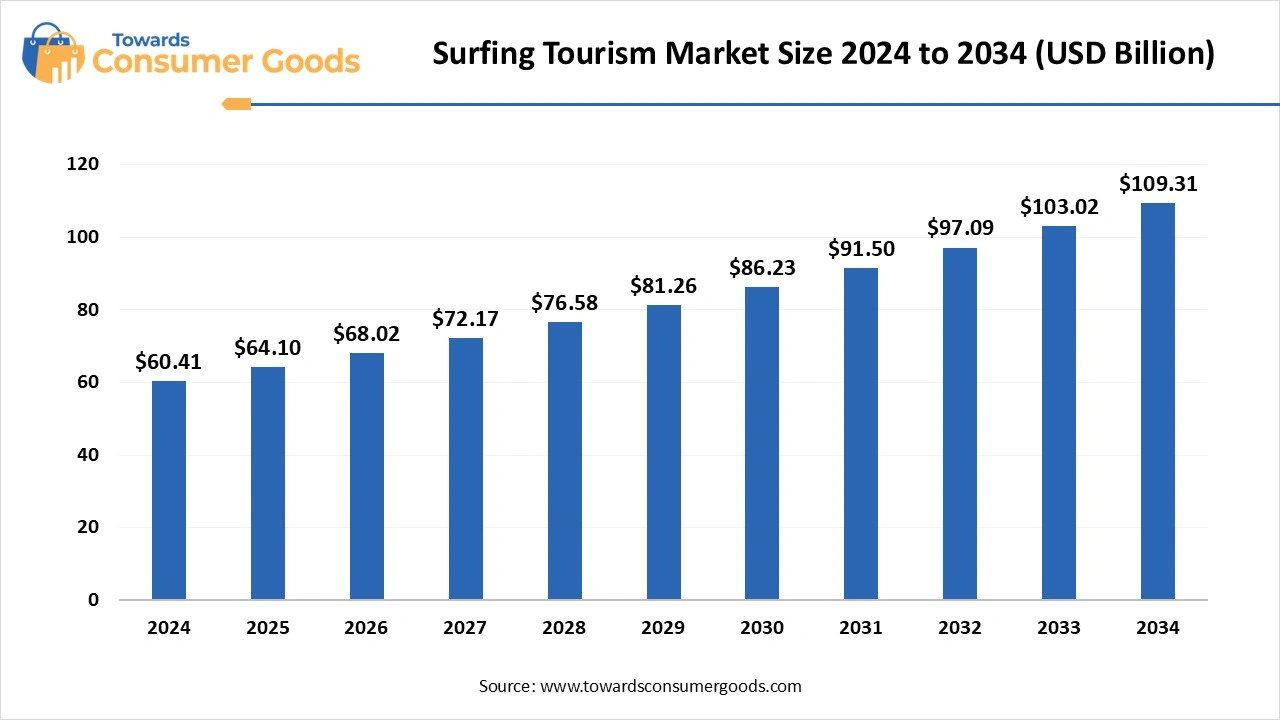
Surfing tourism has evolved from a niche passion into a global economic force, weaving together travel, adventure, lifestyle, and sustainability. Valued in billions, the market is riding high on the surge of interest from millennials, Gen Z, and eco-conscious travelers seeking more than just a vacation experience. Coastal nations from Indonesia and Costa Rica to Australia and Portugal are becoming vibrant hubs for surf holidays, offering curated surf camps, eco-lodges, and cultural immersion experiences.
The rise of social media and digital nomad culture has amplified the visibility of once-remote surf spots, transforming them into bucket list destinations. Add to this the post-pandemic desire for outdoor, wellness-centric travel, and you get a sector that is not only growing but also evolving.
Governments and private players alike are investing in infrastructure, surf schools, and community-based tourism to capitalize on this trend while preserving coastal ecosystems. In essence, surfing tourism is no longer just about riding waves, it is about creating soulful, sustainable, and globally connected experiences.
The sixth Indian Open of Surfing (IOS), a national surfing competition recognized by the Surfing Federation of India (SFI), is set to take place at Tannirbhavi Eco Beach in Mangaluru from May 30 to June 1, 2025. In a media statement, AV Ramana, the Chairman of New Mangalore Port Authority, expressed pride in returning as the title sponsor for this significant event. He noted, “Our partnership with this pivotal occasion reflects our dedication to supporting initiatives that deliver socioeconomic and cultural benefits to the community. We strongly believe that surfing can elevate Mangaluru to a premier destination for ocean sports and ecotourism. We are eager for another impactful edition. (source: thehindubusinessline )
| Report Attributes | Details |
| Market Size in 2025 | USD 64.1 Billion |
| Expected Size by 2034 | USD 109.31 Billion |
| Growth Rate from 2025 to 2034 | CAGR 6.11% |
| Base Year of Estimation | 2024 |
| Forecast Period | 2025 - 2034 |
| High Impact Region | North America |
| Segment Covered | By Type, By Traveler Type, By Travel Style |
| Key Companies Profiled | World Surfaris, G Adventures, Waterways Travel Surf Adventures, Wavehunters Surf Travel, Epic Surf Tours, Stoked Surf Adventures, Witch's Rock Surf Camp, Soul & Surf, Perfect Wave Travel, LUEX Surf Travel |
Growing Popularity of Lifestyle Tourism to Bring Opportunity
The surfing tourism market is brimming with untapped potential, especially in underexplored coastal regions that boast ideal wave conditions but lack commercial exposure. Countries across Africa, South America, and Southeast Asia present lucrative growth corridors for surf tourism infrastructure development, offering natural landscapes, rich cultures, and year-round surf seasons. Moreover, the growing intersection between surfing and lifestyle tourism is opening doors for cross-sector ventures ranging from surf-centric wellness retreats to culinary surf tours and ocean-based adventure packages. With the younger generation prioritizing experiential travel, brands and the government can seize the opportunity to foster local entrepreneurship, build eco-conscious resorts, and introduce educational surf programs.
Despite its rapid ascent, the surfing tourism market faces several hurdles that could stall its full potential. One of the most pressing concerns is coastal overcrowding and environmental degradation. Popular surf destinations often face over-tourism, leading to strained local ecosystems, coral reef damage, and unsustainable development undermining the very beauty that draws surfers in the first place. Another major restraint is inadequate infrastructure in emerging surf regions. While many coastlines may offer perfect waves, a lack of accessible transport, skilled surf instructors, medical facilities, and secure accommodation deters tourist inflow. Additionally, political instability or local unrest in some regions further limits their appeal despite their natural advantages.
Why is North America Known as the Surf Capital of the World?
The North America surfing tourism market size was valued at USD 17.19 billion in 2024 and is expected to be worth around USD 31.15 billion by 2034, exhibiting a compound annual growth rate (CAGR) of 6.13% over the forecast period 2025 to 2034. North America continues to dominate the global surfing tourism market, with California and Hawaii at the epicenter of surf culture and infrastructure. These iconic destinations attract millions of surfers annually with their legendary waves, year-round surf-friendly climate, and world-class surf competitions such as the Vans Triple Crown and Mavericks challenges.
The region's well-developed coastal infrastructure, luxury resorts, surf academies, eco-tourism, and vibrant surf towns create a seamless experience for all types of tourists, from beginners to professionals. Additionally, strong domestic travel, high disposable income, and a deep-rooted legacy ensure a steady and loyal market base.
The main attraction of this venture will be the first Endless Surf wave basin in North America, spanning 4 acres and stretching 800 feet, engineered to provide an exceptional surfing experience.
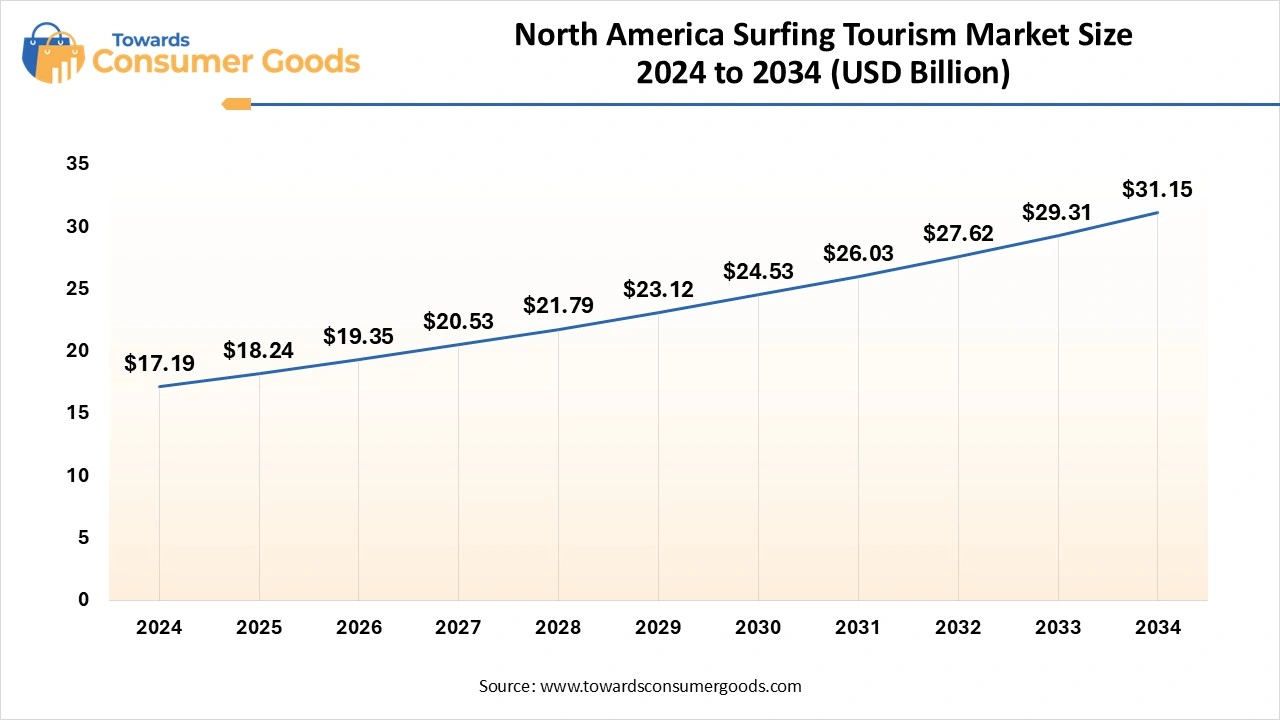
Europe Surfing Tourism Market Trends:
Europe has rapidly emerged as the fastest-growing region in surfing tourism, thanks to its diverse coastlines, rising surf culture, and supportive tourism ecosystems. Countries like Portugal, Spain, and France have carved out strong identities as surf destinations offering Atlantic swells, charming coastlines villages, and affordable surf schools that cater to both local and international visitors.
While Southern Europe's growth is remarkable, with seasonal flexibility. While Southern Europe flourishes in summer, the colder Northern shores of Ireland, the UK, and Norway offer thrill-seekers winter surfing adventures. Additionally, low-cost airlines and well-constructed transport networks make inter-country surf travel feasible and attractive. Europe’s growth is also fueled by sustainability-conscious travelers. Eco-hostels, carbon-neutral surf camps, and localized surf festivals are gaining traction, especially among younger travelers looking for ethical and immersive experiences.
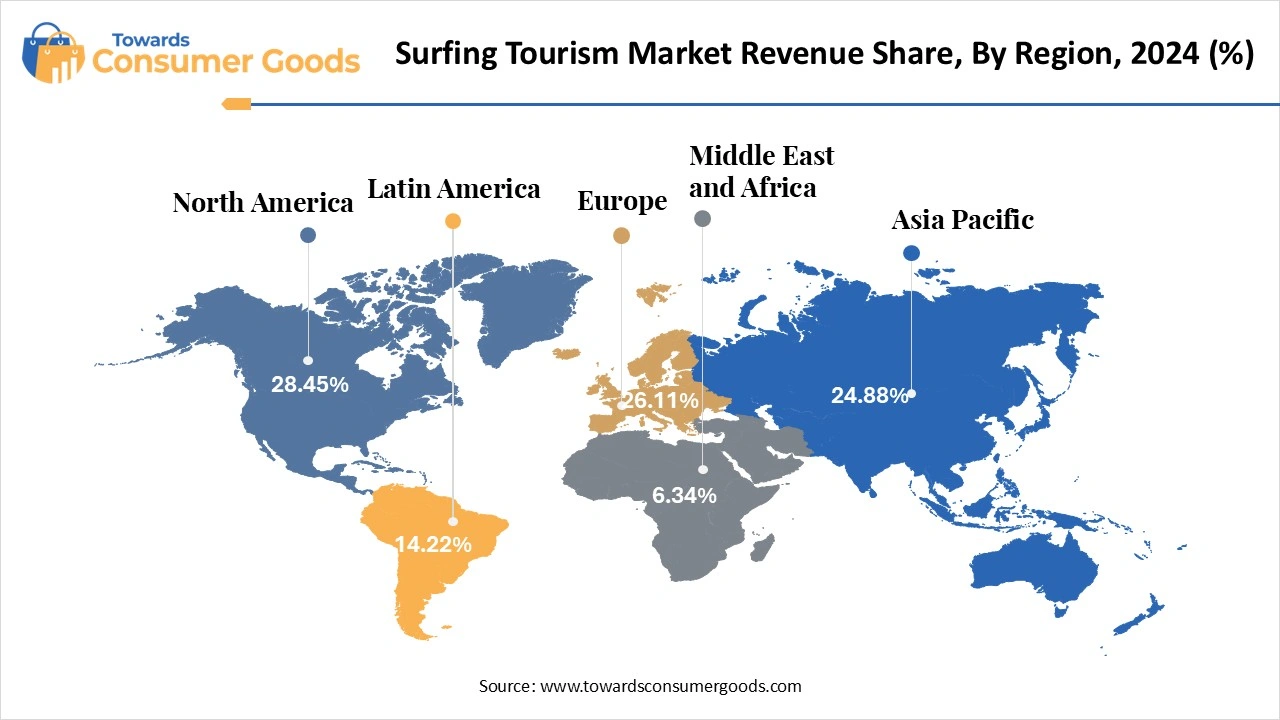
Can Asia-Pacific be the Next Big Wave?
Asia-Pacific is experiencing notable growth in surfing tourism, powered by its powdered by its tropical allure, wave-rich coastlines, and budget-friendly offerings. Countries like Indonesia, Sri-Lanka, the Philippines, and Australia have become magnets for surf enthusiasts seeking uncrowded breaks, cultural immersion, and scenic beauty. Bali continues to be a global hotspot, seamlessly blending surf with spiritual retreats and luxury beach resorts.
Meanwhile, places like Siargao in the Philippines and Arugam Bay in Sri Lanka are rapidly climbing the ranks as international favorites for wave-chasing backpackers and digital nomads. Government-led tourism campaigns, surf festivals, and international competitions have further enhanced the visibility of the region. However, it is the warm hospitality, exotic landscapes, and affordability that truly set Asia-Pacific apart. With infrastructure development on the rise and increased international flight connectivity, the region is poised to become a powerhouse in global surf tourism.
Surf tours and expeditions segment dominates the Surfing Tourism Market, forming the core experience around which the entire market revolves. These curated packages range from beginner-friendly guided sessions to advanced multi-destination surf expeditions that offer structure, safety, and local insight, making them a preferred choice for tourists worldwide. The success of surf tours lies in their flexibility and variety. Whether it’s a day trip to a local beach or a week-long boat safari exploring hidden surf breaks, these tours cater to all skill levels and travel styles. Experienced instructors, equipment rentals, and local knowledge are bundled into one seamless adventure, reducing barriers to entry and elevating the traveler’s confidence and experience.
On the other hand, surf resorts and accommodations are experiencing the fastest growth in the surfing tourist market. From eco-luxury beachfront villas to budget-friendly surf hostels, travelers now seek comfort, community, and convenience alongside their surf adventures. This segment thrives by offering value-added services like in-house surf schools, wellness centers, yoga sessions, and communal spaces that foster a like-minded surf culture.
Regions like Bali, Portugal, and Costa Rica have capitalized on this trend, with properties that blend local aesthetics with modern amenities, ensuring both adventure and relaxation. As surf tourism becomes more lifestyle-oriented, these resorts are evolving into holistic travel hubs where travelers can learn, unwind, connect, and immerse themselves in the local surf scene.
Domestic travelers constitute the dominant segment of surfing tourism, particularly in nations renowned for their extensive coastlines and vibrant surf cultures, such as the USA, Australia, and Brazil. These passionate surfers often return for repeat visits, embark on spontaneous weekend surf adventures, and eagerly participate in seasonal surf festivals, thereby sustaining a robust year-round demand. Their deep-seated familiarity with the local language, culture, and geography empowers them to navigate these experiences with ease, enabling more frequent and impromptu trips. By supporting local enterprises ranging from surf schools and beach cafés to homegrown surf gear brands domestic surfers play a crucial role in invigorating regional surf economies. Additionally, with a growing emphasis on environmental sustainability, many opt for nearby surf spots, aiming to minimize their carbon footprint, which in turn creates a further surge in popularity for local surfing destinations.
On the other hand, international travelers represent the fastest-growing segment of this dynamic market, propelled by the globalization of surf culture and the increasing accessibility of exotic locales. These adventurous souls are captivated by the allure of uncovering new waves, fully immersing themselves in diverse local cultures, and escaping the chill of colder climates for the sun-drenched shores of tropical coastlines. Their generally higher spending power allows them to seek out all-inclusive experiences that blend surfing with adventure, nature, and wellness. From European surfers flocking to the lush landscapes of Bali to Americans exploring the picturesque Pacific Coast of Mexico, the international segment infuses the global surf scene with a refreshing diversity and vibrant energy. This growth is further catalyzed by enhanced international flight connectivity, the rise of digital nomad visas, and global surf competitions that shine a spotlight on lesser-known destinations, positioning them prominently on the world surfing map.
Solo travelers have become the heartbeat of the surfing tourism market, drawn to the unique blend of solitude, personal growth, and camaraderie that the sport offers. Surfing is often seen as a deeply introspective journey, where solo adventurers embrace challenges, confront their fears, and immerse themselves in the healing embrace of nature. Yet, amidst the solitude, solo surf travel also paves the way for vibrant communities, with surf hostels, group tours, and surf camps creating opportunities for connection and cultural exchange. Many destinations cater specifically to these independent explorers, providing safe environments, shared accommodations, and collaborative surf lessons designed to forge friendships and unforgettable experiences. This style of travel holds particular allure for millennials and Gen Z, who increasingly prioritize authenticity, independence, and meaningful adventures over conventional tourism.
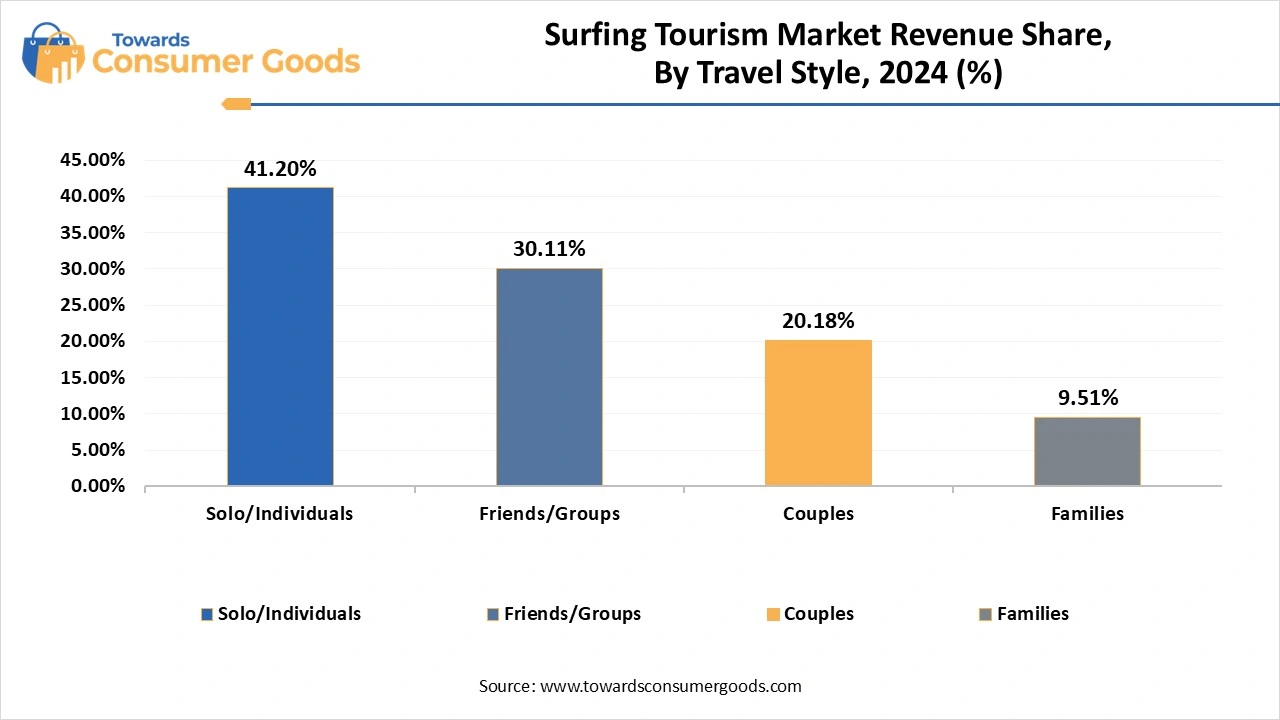
On the other hand, couples’ travelers represent the fastest-growing demographic in surf tourism, captivated by the enticing prospect of merging romance with thrilling escapades. Honeymoon packages designed for surf enthusiasts, couple yoga-surf retreats, and idyllic beach getaways are increasingly marketed as intimate and unforgettable experiences. Many couples opt for surfing getaways to celebrate anniversaries or to tackle shared bucket-list ambitions, indulging in the thrill of riding waves together. In response, resorts are curating tailored experiences that include private surf lessons, soothing spa services, and dual activity itineraries that cater to partners of varying skill levels, ensuring that both enjoy the journey. The emotional bond forged through shared laughter, triumphs, and the exhilarating rush of conquering the waves is transforming surf tourism into a profound and romantic adventure for two, creating memories that linger long after the final ride.
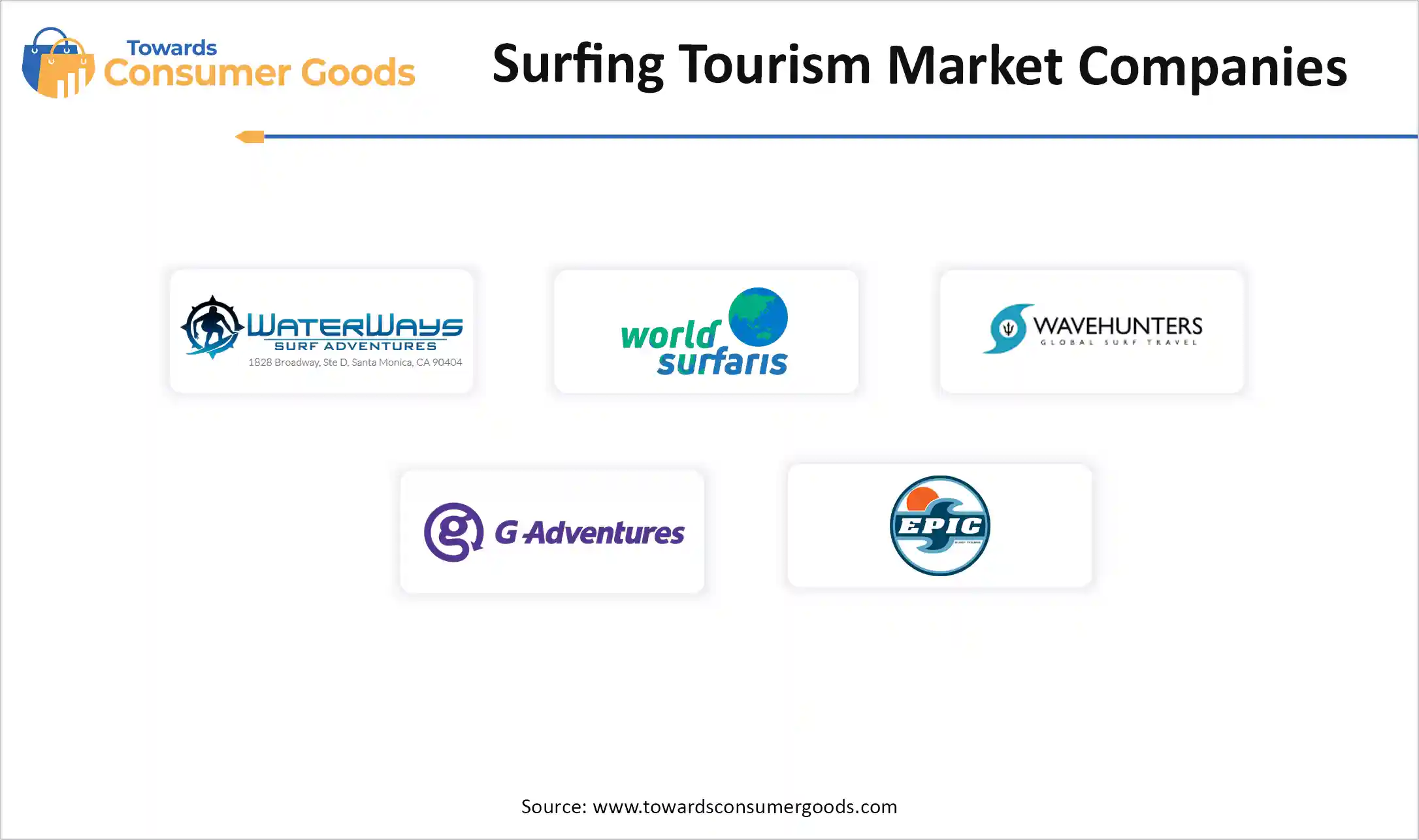
By Type
By Traveler Type
By Travel Style
July 2025
July 2025
July 2025
July 2025